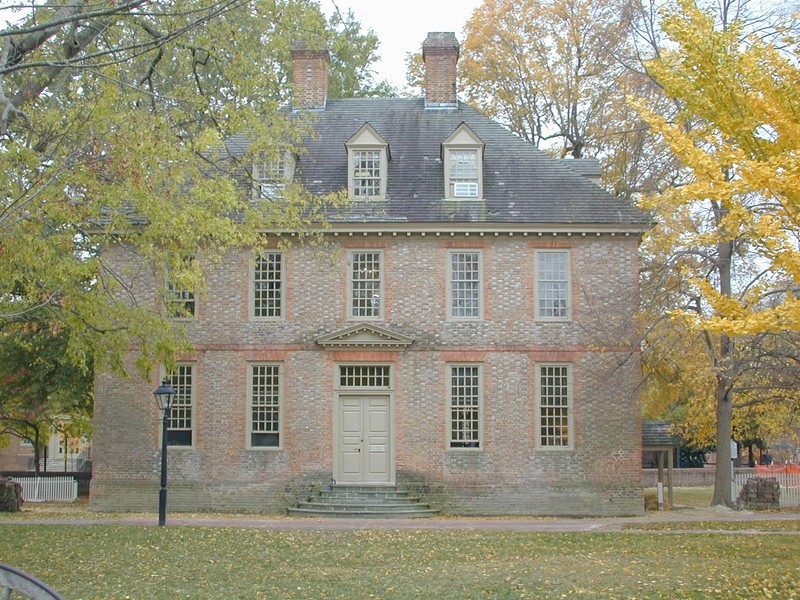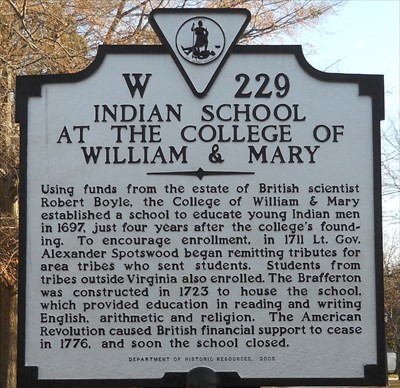Brafferton and the Indian School
Introduction
Author-Uploaded Audio
00:00 / 00:00
Listen to a narration of this entry's description by Victoria Endres.
Text-to-speech Audio
Images
Built in 1723, the Brafferton is the second oldest building at the College of William & Mary. Image obtained from waymarking.com.

Historical marker for the college's Indian School. Image obtained from waymarking.com.

Backstory and Context
Author-Uploaded Audio
00:00 / 00:00
Listen to a narration of this entry's description by Victoria Endres.
Text-to-speech Audio
The original 1693 royal charter establishing the College of William & Mary in Williamsburg originally called for the creation of both a grammar school and an Indian School. The Indian School was meant to educate select Native Americans in European culture and principles. It was hoped that these students, after converting to Christianity and adopting European behaviors, would go on to spread these beliefs to their own tribes. In some instances, tribes sent students willingly; others were diplomatic hostages used to ensure a tribe remained peaceful, while a few were even prisoners purchased by the college. The students came from many tribes ranging from local ones such as the Nansemond, Pamunkey, and the Chickahominy, to as far away as the Cherokee in southern Appalachia and the Delaware in the Ohio River Valley.
The Indian School at William & Mary was supported financially by the estate of Sir Robert Boyle. Boyle was a famous philosopher and scientist, known for developing Boyle’s Law and being one of the founders of modern chemistry. Upon his death in 1691, his will stipulated that a sum of ₤4,000 sterling be used for charitable purposes. His estate utilized that money to purchase Brafferton Manor in Yorkshire, England, and divided the income earned by it between the Indian Schools at Harvard College and William & Mary. Originally the students of the Indian School had classes in the Wren Building and lived with local families. In 1723, the Brafferton building was constructed southeast of the Wren Building to house the Indian School. The two-story brick building is believed to have been built by Henry Cary Jr., the builder of the President’s House and the Wren Building chapel.
Indian School students at the Brafferton attended classes on the first floor and lived in dormitories on the second floor. They were overseen by what was known as the Indian Master, who lived with the students and provided all of their education. Primary subjects taught included reading, writing, arithmetic, and Christianity. Enrollment at the school was low, reaching a peak of twenty-three students but typically averaging eight; some years there was only a single student or none at all. Some students died from European diseases during the school’s early years.
In terms of using the students to spread European customs to indigenous population, the Indian School was largely a failure; many students never even returned to their home tribes. Others did return, but they used their acquired knowledge of European culture to defend their communities. Several former students acted as interpreters and intermediaries between their tribes and the English, translating treaties and assisting in negotiations. Other alumni found themselves in roles that brought them into contact with some of the Founding Fathers; Thomas Step served as a liaison for George Washington during the French and Indian War, while Charles Murphy acted as an interpreter for Patrick Henry.
Funding for the Indian School from the Boyle estate was cut off during the American Revolution, and by 1791 it had shut down. The Brafferton afterwards was used for a variety of purposes such as dormitories, classrooms, and a dining hall. In 1932, it was restored to its colonial appearance as part of a broader project to restore colonial buildings all over Williamsburg. Today it houses offices for William & Mary’s president and provost. In recent years, more efforts have been made to acknowledge the history of the university’s Indian School. In 2016, the Muscarelle Museum of Art showcased a temporary art exhibit titled “Building the Brafferton: The Founding, Funding, and Legacy of America’s Indian School.” Through a series of galleries, the exhibit detailed the origins of the school, its legacy, and the stories of several students.
Cite This Entry
Straley, Steven Cody and Victoria Endres. "Brafferton and the Indian School." Clio: Your Guide to History. September 6, 2020. Accessed April 24, 2025. https://theclio.com/tour/1421/5
Sources
Bridges, Heather. “Remembering the story of William and Mary’s Brafferton Indian School.” The Virginia Gazette. October 29, 2016. Accessed August 17, 2017. www.vagazette.com/life/va-vg-brafferton-1029-20161029-story.html.
“The Brafferton.” College of William & Mary. Accessed August 17, 2017. www.wm.edu/about/history/historiccampus/brafferton/index.php.
“The Indian School at William & Mary.” College of William and Mary. Accessed August 17, 2017. www.wm.edu/about/history/historiccampus/indianschool/index.php.
Image 1: https://s3.amazonaws.com/gs-waymarking-images/7ffb5931-570b-4012-8351-03c48fb6fb3d.JPG
Image 2: https://s3.amazonaws.com/gs-waymarking-images/470d5c4e-89d2-4cfd-ab06-797cfc210d49_d.JPG

